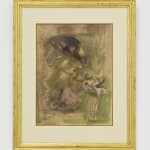



Frances Hodgkins
Portrait of Mrs Elizabeth Curtis, 1939
charcoal and watercolour on paper
527 x 393mm
790 x 635mm framed
790 x 635mm framed
Further images
Mrs Elizabeth Curtis was great a supporter of Frances Hodgkins and was a collector of her work. She was the headmistress and sole proprietor of a progressive boarding school for...
Mrs Elizabeth Curtis was great a supporter of Frances Hodgkins and was a collector of her work. She was the headmistress and sole proprietor of a progressive boarding school for girls called Langford Grove from 1923 until 1962, which had a focus on music, literature and the arts. Hodgkins described Mrs Curtis as ‘gorgeous’ and as having a ‘towering personality.’ 1 In a letter to Dorothy Selby in 1939, Hodgkins writes of Mrs Curtis, ‘[she] looked like a duchess, a rather theatrical one with a fashionable hat set at quite the wrong angle on masses of auburn hair. I longed to paint her & some day must. A mustard coloured frock & leopard skin to crown all. She really was marvellous & every 2nd word or so was superlative. I thoroughly enjoyed her visit.’2
In Portrait of Mrs Elizabeth Curtis, Hodgkins uses fluid, confident strokes to describe Mrs Curtis. There is a feeling of quiet, self-assurance in the subject with closed eyes and a distinctive violet hat. She is portrayed in the same manner as the orchids that sit on a surface before her, though space beyond this distinction is compounded. Figure and form are foremost, both imbued with a quiet vitality.
In 1945, Hodgkins was included in a group exhibition at The Lefevre Gallery in London, along with Henry Moore, Matthew Smith, Graham Sutherland and Francis Bacon, an exhibition which ‘earned her overwhelming accolades.’3 Portrait of Mrs Elizabeth Curtis was included in a subsequent retrospective exhibition at The Lefevre Gallery in 1946, at which point Hodgkins was highly regarded as a visionary, and leading modernist of her time.
In Portrait of Mrs Elizabeth Curtis, Hodgkins uses fluid, confident strokes to describe Mrs Curtis. There is a feeling of quiet, self-assurance in the subject with closed eyes and a distinctive violet hat. She is portrayed in the same manner as the orchids that sit on a surface before her, though space beyond this distinction is compounded. Figure and form are foremost, both imbued with a quiet vitality.
In 1945, Hodgkins was included in a group exhibition at The Lefevre Gallery in London, along with Henry Moore, Matthew Smith, Graham Sutherland and Francis Bacon, an exhibition which ‘earned her overwhelming accolades.’3 Portrait of Mrs Elizabeth Curtis was included in a subsequent retrospective exhibition at The Lefevre Gallery in 1946, at which point Hodgkins was highly regarded as a visionary, and leading modernist of her time.
Provenance
Acquired by Elizabeth Curtis from Frances HodgkinsBy descent to Dunstan Curtis, Powys, Wales
Phillips, London, England, June 1989
Private collection
Exhibitions
Frances Hodgkins (as Portrait of Elizabeth Curtis with Orchid), The Lefevre Gallery, London, England, November 1946Revisiting Modernism, Gow Langsford Gallery, Auckland, New Zealand, 27 September–14 October 2023
Frances Hodgkins, Creating Space, 21 May - 25 June 2025, Gow Langsford, Auckland, New Zealand
Literature
Arthur R. Howell, Frances Hodgkins: Four Vital Years (London: Rockliff, 1951), p. 101Roger Collins and Iain Buchanan, Frances Hodgkins on Display 1890–1950 (Dunedin: Hocken Library, 2000) p. 88


